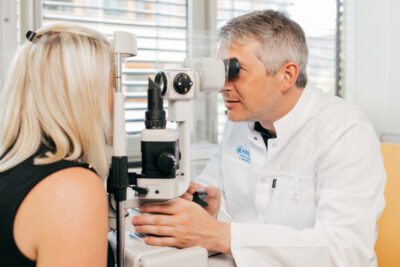
Clear vision without glasses or contacts with PRK in Bratislava
Experience this proven, surface-based laser treatment that gently reshapes your cornea for long-term clarity
With PRK, patients can achieve clear vision without lenses
Quickly discover how this gentle laser procedure offers long-lasting visual freedom
Suitability criteria
PRK is ideal for adults over 18 with stable prescriptions and no underlying eye disease. It’s suitable for patients with myopia up to -6.00 diopters and astigmatism up to -3.00.
PRK is often recommended for people with thin corneas or those involved in contact sports, where flap-based procedures like LASIK might not be appropriate.
If you have dry eyes or are not eligible for other laser surgeries, PRK may be a safer and more effective option.
How PRK works
PRK (Photorefractive Keratectomy) is a surface-based laser procedure. After numbing drops are applied, the outermost layer of the cornea (epithelium) is gently removed. An excimer laser then reshapes the underlying corneal tissue to correct the refractive error.
Unlike LASIK or FemtoLASIK, PRK does not involve creating a corneal flap. A protective contact lens is placed to aid healing, and the epithelium naturally regenerates over the next few days. The procedure takes only a few minutes per eye, and patients go home the same day.
Advantages & Disadvantages
PRK is a trusted method with no corneal flap, making it safer for patients with thin corneas or those at risk of eye trauma. It’s also suitable for dry eye sufferers.
Healing takes longer compared to LASIK or SILK, and there can be discomfort for a few days post-op.
However, the long-term outcomes are excellent, with most patients achieving 20/20 vision or better. It’s a reliable solution with a long track record of success.
Risks of PRK
Like all surgeries, PRK carries some risks. Temporary side effects may include light sensitivity, dry eyes, or hazy vision during healing. Infection or delayed epithelial healing is rare but possible.
Night glare and halos can occur, especially in the early recovery phase. Your surgeon will thoroughly assess your eye health and advise if PRK is the safest option for you.
Options & Alternatives
If PRK isn’t right for you, other laser options include LASIK or FemtoLASIK, which offer quicker healing times but involve flap creation.
LASEK is another surface-based technique that preserves more corneal structure. SILK (a lenticule extraction technique) and Refractive Lens Exchange (RLE) are alternatives for higher prescriptions or ageing eyes.
Your suitability will be assessed during a consultation.
Steps of PRK
The PRK journey begins with a detailed eye examination.
On the day of surgery, the eye is numbed, and the epithelium is gently removed. The laser then reshapes the cornea to correct your prescription. A contact lens is placed to protect the eye and assist healing. The procedure takes just a few minutes.
You’ll go home the same day and return the next day for a follow-up. Full recovery may take several days, but vision steadily improves during this time.
Results of PRK
PRK offers excellent outcomes, especially for those who aren’t candidates for flap-based procedures.
Most patients achieve 100% vision or better, although it may take a bit longer compared to LASIK. Once healed, results are stable and long-lasting.
Many patients report increased confidence, comfort, and freedom from glasses or contacts. Your final visual outcome depends on your initial prescription and healing process.
3 easy steps to free yourself from glasses and contacts
Laser eye surgery options can feel overwhelming. We’ve made it simple

Step 1:
GET IN TOUCH
The first step is to find out if you’re suitable. Not everyone is a match for laser eye surgery, so it’s important to get the facts first.
Use our easy calendar to book an appointment.
Step 2:
WE’LL MEET
At your appointment, we’ll carry out detailed tests to understand your eyes and your lifestyle.
We’ll explain everything clearly and give you a personalised recommendation. You’ll leave knowing exactly what to expect — and whether laser eye surgery is right for you.
Step 3:
ENJOY FREEDOM
Afterwards, you’ll start to see the difference. Most people mention that they wish they had done it years earlier! When people say yes to eye treatment, they say yes to a new life, free from the limitation of glasses and contacts!
Book an appointment
Take it easy. Our procedures are contact-free, with no incisions or pain.
Book an appointment
Take it easy. Our procedures are contact-free, with no incisions or pain.



